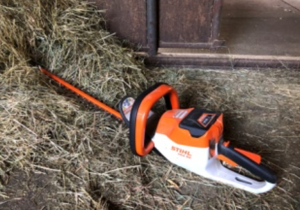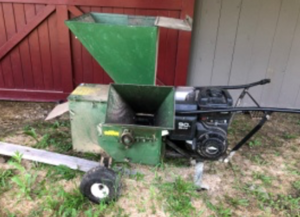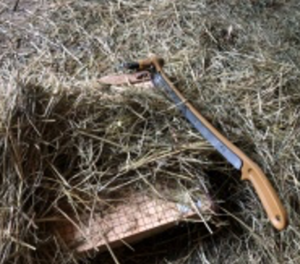Editor’s Note:
This week, we hear from Debbie Hight. She is a former BHPS board member, horse owner, and occasional guest columnist for Cayuse Communications. She writes from her home in Maine, where she cares for dogs and horses, especially her lovely Morgan mare, Roxy, who was a demonstration horse at the Summit in Maine in 2019.
Debbie writes:
Greetings from soggy Maine, the rainiest June that I can ever remember. While it has seemed to keep the bugs down, no one can harvest hay, and we are about two weeks behind now and the forecast is not looking any brighter.
So, this is just another challenge in the world of horsemanship. But listening to the Best Horse Practices podcasts, you will be entertained and find answers to questions that you may or may not have. A recent podcast on DIY projects around the barn and farm highlighted the fun of being resourceful and cheap. That spirit of resourcefulness resides somewhere in all of us, and often sprouts from real need.

Hedge trimmers
Quid. Another four letter word in the world of horses. My retired standard bred racehorse, Post Card Jack is now 33. When he turned 30, I noticed occasional quidding. I’d respond with various selections of hay, an occasional bute, and he’d be back to normal. Visits from the vet and tooth fairy indicated a wearing away of teeth, but nothing extraordinary, given his age. There was some thought that putting a speculum in his mouth may have caused some kind of misalignment, that ultimately resurrected itself.
This spring, he began to quid excessively. I had just dewormed him. Had the syringe in his mouth caused a misalignment? The vet came to check, saw nothing out of the ordinary, suggested maybe TMJ. I had a Masterson practitioner come and while he loved the work, no chewing miracles occurred. Fortunately, we were just getting the beginning of spring grass, so I sent him out during the day, though it was “different” and he spent a good part of each day in the run in, not eating.

Chipper
Introducing resourcefulness… I tried several of my pieces of equipment to chop hay. The hand pruner failed miserably. Hay caught in the chain. But my hedge trimmer did the job well. I learned, after having to replace the expensive blades, that if I carefully cut one flake at a time, like brownies; flipped it over and cut the other side, that maybe I could preserve those blades. I mixed first, second, and third crop and found success. But I had to buy a second hedge trimmer while the first one was fixed. Resourceful perhaps, but not cheap.
Being a retired teacher, I dug out my old paper cutter. That chopped the hay, but it was pretty arduous. But it was there in a pinch. Resourceful and cheap. I looked into a larger paper cutter, resourceful but not cheap.

Lucerne Farms Hi FI
We also had an old chipper in the barn, where it had been parked for 20 years. After cleaning, a new carburetor, and I’m not sure what else (I was not that resourceful!), it started up. But it was really a shredder that forced the hay, slowly, down through a screen. We ended up with a lot of dust. So, I called the company, found they had a larger screen, ordered it, and it works. Resourceful, not cheap. But it does take more time to use than the hedge trimmer, so it is there as backup.
Hay chippers that landscapers use to cover new lawn would have blown hay everywhere. Scratched that idea. Apparently, there is a roof shingle cutter that might work, moderately priced, but I haven’t resorted to buying one of those yet.
I learned about Lucerne Farms hay products at the Best Horse Practices Summit. Jack didn’t like the first bale I bought, but he will eat the High Fiber. He gets a bowl of it each night.

And, yes, even a paper cutter!
Postcard Jack is thriving. He still moves very well and his weight is stable. He is doing well on grass; twice daily giant mashes of beet pulp, hay extender, alfalfa pellets, and grain; Lucerne High Fiber; and chopped hay. His stall looks like a buffet table. He has freedom to move around 24/7, but he still spends most of the night in his stall. Recently, I have been experimenting with unchopped hay and he seems to be able to chew the second crop quite well. Hooray!
So, Maddy has asked for “summer projects” and I’m sure that many of you have faced quidding. Perhaps my suggestions have helped, though I ‘m sure many of the resourceful readers have found other solutions. Please let us know!
I like your ideas, thanks! I have two retired college equestrian team horses, a Quarter Horse gelding (age 28) and a Dutch Warmblood mare (age 26). They both quid, but my boy even quids tender short grass. Here are the solutions we have found that work well for us. We soak their pelleted low starch feed to make a mash ever since the mare choked on the dry pelleted feed. (Yikes!) To their feed, we add 1/2 cup raw/unstabilized rice bran , canola oil , and Cool Calories Fat supplement (vegetable fat) twice a day. We also give them two cups of beet pulp soaked with their Alfalfa Bermuda hay cubes twice a day. We call them slurpies….they love them as well or better than their feed! LOL! They are both doing well on this regimen. I give them Bermuda hay to play around with some days, but their main hay intake is the soaked Alfalfa Bermuda hay cubes.
Hi, Great problem solving. Another approach we found at Montana Horse Sanctuary that works well for elders are hay pillows. They have to pull just 2-3 strands of grass at a time and not having so much in their mouth helps them chew more easily. Many of the elders we’ve used these with gained their weight back nicely and ate comfortably. Find hay pillows – while lie on the ground at Thehaypillow.com
Thank you for this little article. I have a 34-36 year old mare that I smorgasbord feed too. She has mash of Blue Seal hay stretcher and Nutrena Fuel (which she likes quite well), a quart of Sentinel LS Performance (dry) in a black feed tub on the floor and soaked Poulin Alfalfa cubes (she specifically prefers these cubes) in a black feed tub on the floor, plus as much soft high quality second cut hay as she wants (usually around 2 leaves she eats) each evening. The game changer for her is Equioxx daily. I guess cheaper than replacing hedge choppers 🙂 She seems happy for now.